Heritage Trees
Vancouver’s Heritage Tree program aims to preserve and recognize the significant trees in our community. The City of Vancouver believes that by preserving our natural resources we preserve a vital link to our past.
Join the Heritage Tree Bike Ride each summer for a guided tour of some of the amazing trees on the registry.
Benefits of Participating in the Heritage Tree Program:
- The program provides a way for people to save significant trees on private property where a tree removal permit is not applicable.
- Heritage trees are protected from unnecessary removal and aggressive maintenance actions with review and appropriate approval of all activity by the Urban Forestry Commission.
- Heritage Trees will have plaques with their designation on or adjacent to the tree.
- The Urban Forestry Commission and City of Vancouver will strive to create partnerships with local tree care companies or sponsors for the care and maintenance of Heritage Trees.
- All Heritage Trees will be inventoried with all relevant information and photographs for interested parties to research. View the current Heritage Tree Inventory.
How to Nominate a Tree
The Heritage Tree Program was established in 1998. If you have or know of a special tree or a grove of trees that might be considered for Heritage Tree status, please review the program criteria listed below and contact the Urban Forestry Program at 360-487-8332, or return the Heritage Tree Nomination Packet to Vancouver Urban Forestry.
The Heritage Tree selection process is on-going. To be nominated, a tree must be in good condition and have the consent of the property owner. Consent is binding and will apply to all future property owners, successors, or heirs. Tree nominations are reviewed by the Urban Forestry Commission. Heritage Tree status is granted if the tree meets any or all of the following requirements:
- Size – a diameter of at least 36 in
- Special site location
- Relation to an historical event
- Unusual species for the area, or exemplary form for the species
- A grove may be considered if it meets any of the following requirements:
- Mature and contains trees that are distinctive due to size, shape, species, or age
- Associated with a historical event
- Relationship with a natural resource (i.e. stream bank)
- City code chapter 20.77.120 – Heritage Trees
Old Apple Tree Festival
The annual Old Apple Tree Festival is a celebration centered on the oldest living apple tree in the Northwest, planted at Fort Vancouver in 1826.
Visit Our Heritage Trees
How many of Vancouver’s Heritage Trees have you seen? Which is your favorite? Join Urban Forestry for a tour of Heritage Trees by bike each June.
American Chestnut
Castenea dentata
History/Information
These two trees sit on the west and east sides of the Howard House, located near the historic Officer’s Row and are very rare indeed. Until the early 20th century, The American chestnut was the dominant forest tree in the eastern United States until an exotic disease, chestnut blight, was introduced in the early 1900s. In what can be described as one of the most devastating environmental disasters in American history, chestnut blight destroyed the entire native range of American chestnut and pushed them the brink of extinction. There are an estimated 300-500 mature American chestnuts remaining and based on historical photos, these two particular trees were likely grown from seed prior to 1890.
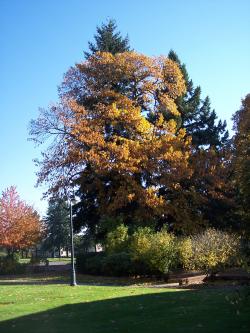
Statistics
DBH (diameter at breast height): 53 & 41 inches
Height: 90 & 62 feet
Spread: 70 & 50 feet
Location: O. O. Howard House, Officer’s Row
Heritage Tree ID: HT35 & HT36
Bigleaf Maple
Acer macrophyllum
History/Information
Noteworthy for its size and age, this tree was also retained as part of the new Fire Station 2 construction in 2017 resulting from neighborhood input and support. The tree is the single relic of the former John Rogers Elementary School which used to occupy the site, and serves as a connection for neighbors to the area’s past and nostalgia for the many alumni of the school who played underneath the tree’s shade years ago.

Statistics
DBH (diameter at breast height): 48 inches
Height: 60 feet
Spread: 65 feet
Neighborhood: Maplewood
Location: Fire Station 2
Heritage Tree ID: HT44
Bigleaf Maples
Acer macrophyllum
History/Information
These two large bigleaf maples stand out in Clearmeadows Park and have been used as a gathering place and picnic spot by neighborhood residents for years. Their beautiful fall color adds character and distinction to both the park and the neighborhood. Loved by local residents and visitors alike, these two majestic native trees truly define the neighborhood and area.
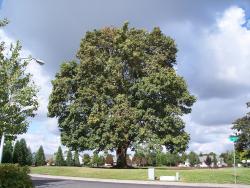
Statistics
DBH (diameter at breast height): 55.5 & 57 inches
Height: 80 & 65 feet
Spread: 65 & 50 feet
Location: Clearmeadows Park (intersection of Southeast 23rd Street and Southeast 182nd Avenue)
Heritage Tree ID: HT22, HT23
Black Cottonwood
Populus trichocarpa
History/Information
This Black Cottonwood is one of the largest trees in the neighborhood. The tree provides a grand backdrop to John Ball Park because of its enormous size and shape. While naturally found along rivers and streams in the western United States, black cottonwoods can be grown as ornamental trees, valued for their fast growth and scented spring foliage, detectable for hundreds of feet away. The tranquil sounds of the leaves quivering in the wind can be heard around the park.

Statistics
DBH (diameter at breast height): 67 inches
Height: 106 feet
Spread: 75 feet
Neighborhood: Hough
Location: John Ball Park
Heritage Tree ID: HT38
Black Locust
Robinia pseudoacacia
History/Information
This tree was nominated by Ms. Treosti, a long-time teacher at Mill Plain Elementary School. The tree was planted at the historic schoolyard as an Arbor Day project around 1910 or 1912 when it was Union High School. In 1982 the tree was slated to be removed for parking spaces. Ms. Treosti and her third grade students petitioned the School Board to save the tree. The tree was preserved and eventually received Heritage Tree designation. Seven of Ms. Treosti’s former students returned for the Heritage Tree Dedication ceremony on National Arbor Day in 2000.
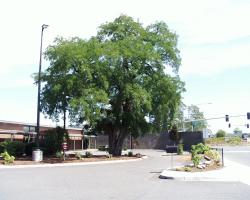
Statistics
DBH (diameter at breast height): 47 inches
Height: 55 feet
Spread: 60 feet
Neighborhood: East Mill Plain
Location: Mill Plain Elementary School
Heritage Tree ID: HT11
Black Walnut
Juglans nigra
History/Information
This large black walnut tree is among the largest trees in the neighborhood, showing off a full, well-formed trunk devoid of branches a considerable distance from the ground and an oval, open canopy. It is said that this tree is part of the Hudson Bay Company’s groves, and that people used to tie horses under it for visiting the farmers market.
Typical of the species, the bark is dark brown to grayish black, divided by deep, narrow furrows forming roughly a diamond-shaped pattern. Native from Massachusetts to Florida and west to Minnesota and Texas, black walnuts grows best in deep, rich, and moist soils.

Statistics
DBH (diameter at breast height): 68 inches
Height: 90 feet
Spread: 60 feet
Neighborhood: Arnada
Location: 1904 H Street
Heritage Tree ID: HT47
Black Walnut
Juglans nigra
History/Information
The black walnut tree sits on the south perimeter of Arnada Park at the dead-end of “G” street. It is a prominent landmark in the neighborhood.
Black walnut, a rapidly growing tree, is most common in moist bottomlands and open fields of the Midwest, but can be found everywhere due to squirrels burying its nuts. Its beautiful, fine-grained, chocolate-brown, relatively lightweight heartwood is the ultimate choice for making solid wood furniture, interior trim, gunstocks, and high-quality veneer.
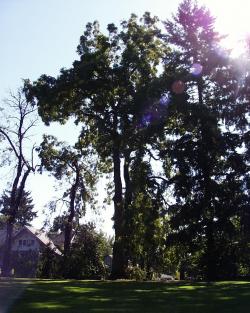
Statistics
DBH (diameter at breast height): 55.5 inches
Height: 90 feet
Spread: 75 feet
Neighborhood: Arnada
Location: Arnada Park
Heritage Tree ID: HT14
California Bay Tree
Umbellularia californica
History/Information
This tree, which has been used as a meeting spot for the children of Arnada neighborhood for years, is also affectionately known as “Curmudgeon Park”. This is in reference to the previous homeowner’s periodic “notes from the neighborhood curmudgeon” that were included in the neighborhood newsletter.
The leaves from this very aromatic tree were used by native peoples in the treatment of headaches and poison oak rashes as well as to repel fleas. The leaves have also been used as a substitute for traditional bay leaves in cooking, but with a much stronger flavor.

Statistics
DBH (diameter at breast height): 41 inches
Height: 45 feet
Spread: 40 feet
Neighborhood: Arnada
Location: 401 East 22nd Street
Heritage Tree ID: HT18
Chestnut Oak
Quercus prinus
History/Information
Native to the Appalachian region of the United States, this tree was sent as a seedling from George Washington’s plantation, Mount Vernon, as a gift to the local Free and Accepted Mason’s Lodge #4 and planted in 1931 to celebrate the 75th anniversary of the lodge.The tree is located in the Mason’s section of the Old City Cemetery on Mill Plain Boulevard.
Also known as rock oak or basket oak, the tree is valued for its bark which is richer in tannin acid (11%) than any other of the oaks making it useful in the tanning of leather.
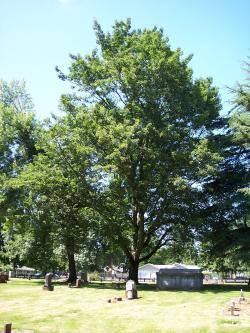
Statistics
DBH (diameter at breast height): 38 inches
Height: 85 feet
Spread: 80 feet
Location: Old City Cemetery
Heritage Tree ID: HT24
Coast Redwood
Sequoia sempervirens
History/Information
The tree is located on the eastern edge of Leverich Park, adjacent to multiple recreation opportunities along Burnt Bridge Creek and is used as a landmark for many of the disc golf players in the park. Cyclists entering the park ride by a view of the upper canopy and descend into the greenspace under the branches and ride by the tree’s unique trunk.
Coast redwoods are among the largest and oldest living beings on Earth, living to 1,200 years or more and growing over 350 feet tall. They are resistant to insect attack, fungal infection, and rot as a result of high concentrations of terpenoids and tannic acid in their leaves, bark, wood, and roots.
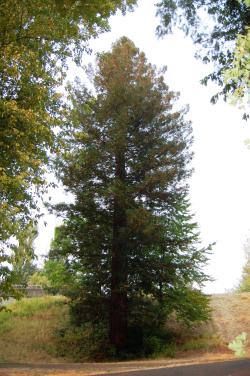
Statistics
DBH (diameter at breast height): 76 inches
Height: 80 feet
Spread: 25 feet
Neighborhood: West Minnehaha
Location: Leverich Park
Heritage Tree ID: HT42
Conifer Grove at Esther Short Park
Mixed species
History/Information
In the 1800s, the Short family used the park for cattle and hogs. In 1853 the land became the first public park in the Pacific Northwest with small additions of park amenities. Unfortunately, the Columbus Day storm in 1962 severely damaged a large number of trees in the southeast corner resulting in their removal. The location and cultivation of the existing trees imply that no formal landscape design was ever done for Esther Short Park. The conifers in this grove, associated with the 1937 Grand Army of the Republic, have been designated as Heritage Trees. The western red cedar has a plaque in honor of the past Department President Sarah Tomlinson Parker at the base of the tree. An article in The Columbian also mentions the dedication of at least another tree for past Department Commander George E. Hill; however, no plaque relating to this honor is found in the park. Because of the relatively similar size of some adjacent cedars, and two significantly large giant sequoias, the trees are considered a “grove”.
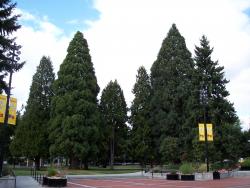
Statistics
DBH (diameter at breast height): 45+ inches
Height: 80+ feet
Spread: 50+ feet
Neighborhood: Esther Short
Location: Esther Short Park
Heritage Tree ID: HT9
Crimson King Maple
Acer platanoides ‘Crimson King’
History/Information
A cultivar of Norway maple, Crimson King has probably the most consistent color of the red leafed maples and may be the most vigorous as well. Commonly planted throughout the United States, Crimson King adapts well to a multitude of environments and can tolerate a variety of soils, shade and drought. This tree illustrates why the Crimson King maple is such a prized landscape tree.

Statistics
DBH (diameter at breast height): 33.5 inches
Height: 60 feet
Spread: 45 feet
Location: 2003 Southeast 141st Place
Heritage Tree ID: HT26
Deodar Cedar
Cedrus deodara
History/Information
An excellent specimen of the species, this Deodar Cedar demonstrates an extremely graceful, pendulous branching habit making it a popular choice among gardens. Native to the western Himalayas as a subalpine tree, the species has been planted in the Pacific Northwest from early on in its modern history. This Deodar Cedar prominently watches over the historic Hough neighborhood and has witnessed much of the city’s growth. The house has been held by the same family since it was built. Dr. Thomas Elliot built the home and planted the tree in approximately 1928.
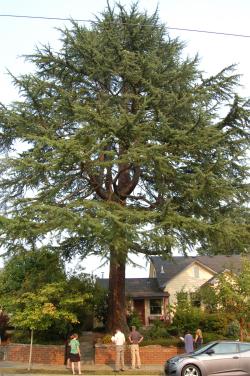
Statistics
DBH (diameter at breast height): 44 inches
Height: 115 feet
Spread: 90 feet
Neighborhood: Hough
Location: 2001 Daniels Street
Heritage Tree ID: HT46
Deodar Cedar
Cedrus deodara
History/Information
This backyard Deodar Cedar presents an unusual structure and history. Wide-spreading branches give the tree a beautiful pyramidal form and its trunk splits into multiple smaller trunks partway up the tree. The house at this property was struck by the tornado of 1972 and it is thought that the tree was hit as well, possibly causing the tree’s top to fail and sprout multiple new leading stems. In healthy condition, the tree appears to have recovered and stood the test of many other storms since.

Statistics
DBH (diameter at breast height): 39 inches
Height: 70 feet
Spread: 65 feet
Neighborhood: Dubois Park
Location: 409 Tucson Way
Heritage Tree ID: HT49
Douglas-Fir Grove
Pseudotsuga menziesii
History/Information
This grove is located in the middle of the Parkside Neighborhood and is a significant grove of native trees within Diamond Park. The land was first purchased by James Davidson in the 1870s and before that was used as a travel route by indigenous people of the area. The trees have been on this land since before 1955 when aerial photos first started being taken. At that time, Jack White and his family owned the land in the middle of present-day Parkside which contained a dairy farm.
In 1991, Jack sold the property to Clark County to create a park, allowing for a safer place for neighborhood children to play. The Douglas-firs are mentioned in the land appraisal for their high value.
An obituary for Henry Wagner, a resident who once owned property in the neighborhood when it was still dominated by farms and forests, mentions the “great trees”, “great forest”, and “the log house under the old apple” which may refer to the grove and adjacent groves.
The Diamond Park Heritage Tree Grove represents the past, present, and future of the Parkside neighborhood, its people, and its natural resources.
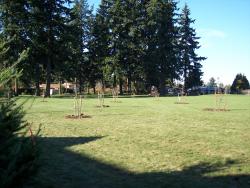
Statistics
DBH (diameter at breast height): varies; the largest is just below 50 inches
Height: varies
Spread: varies
Neighborhood: Parkside
Location: Diamond Park
Heritage Tree ID: HT40
Douglas-Fir Grove
Pseudotsuga menziesii
History/Information
Known to neighbors as the Barton-Noll grove, this portion of West 32nd and 33rd Streets heavily forested with Douglas-fir trees dates to as early as the late 1800s when the block was platted. Nearby residents state they moved to and live in this area because of the mature grove. Pilots flying into Pearson Airpark often use this grove as a point of orientation, standing out among the built downtown environment. The trees are a neighborhood landmark and foster a unique sense of place in the heart of the city.

Statistics
DBH (diameter at breast height): varies
Height: varies
Spread: varies
Neighborhood: Carter Park
Location: 318, 401, 404, 406, & 505 West 32nd Street, 319 West 33rd Street
Heritage Tree ID: HT37
European Beech
Fagus sylvatica
History/Information
The Slocum House, located at the corner of Esther Street and 6th Street, was moved to the Esther Short Park site in 1966. The beech was planted in 1974 to mimic the landscape setting at the original location of the Slocum House.
With countless cultivated varieties, the European beech is one of the most versatile landscape trees. It offers a beautiful form and lustrous foliage in the summer, beautiful fall color, and interesting bark in the winter. Its nuts are prized by wildlife in winter.
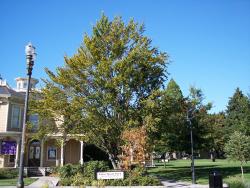
Statistics
DBH (diameter at breast height): 28 inches
Height: 25 feet
Spread: 25 feet
Neighborhood: Esther Short
Location: Esther Short Park (in front of Slocum House)
Heritage Tree ID: HT10
Giant Sequoias
Sequoiadendron giganteum
History/Information
Nominated by the Ellsworth Spring Neighborhood Association, these two trees are over 75 years old and highly valued by both the neighborhood and the elementary school that they sit on. Giant sequoias are the largest trees in the world in terms of overall volume and can grow to average heights of 250 to 300 feet and 20 to 25 feet in diameter in the wild. Record trees have been measured at 311 feet high and 56 feet in diameter. The oldest giant sequoia by ring count is over 3,500 years old.
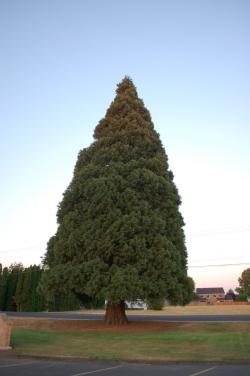
Statistics
DBH (diameter at breast height): 43 & 55 inches
Height: 68 & 75 feet
Spread: 32 & 45 feet
Location: Ellsworth Elementary School
Heritage Tree ID: HT33 & HT34
Green Ash
Fraxinus pennsylvanica
History/Information
This tree is a distinctive species, size, and an excellent specimen of the species. Native to eastern and central North America, the Green Ash is prized for its good form and resistance to disease where it is widely planted as a street tree. North American native ash trees also provide important food sources to wildlife, particularly along bodies of water where they are naturally found the most. Ash trees in North America are currently threatened by the Emerald Ash Borer insect, but the species is otherwise known to have a lifespan of as high as 600 years.
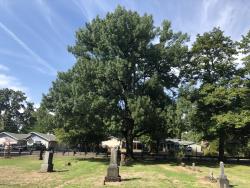
Statistics
DBH (diameter at breast height): 34 inches
Height: 65 feet
Spread: 75 feet
Neighborhood: Central Park
Location: Old City Cemetery
Heritage Tree ID: HT41
Giant Sequoia
Sequoiadendron giganteum
History/Information
Likely planted around 1970 shortly after the Edelweiss residential subdivision was completed, this Giant Sequoia demonstrates a spongy, rich reddish brown bark and dense foliage forming a pyramidal form that is signature of the species. The strong-growing, upright tree is loved by neighbors and acts as a point of reference around the neighborhood, the apex of the tree prominently visible above rooftops. The tree’s massive size, prominent location, and elegant beauty allow it to easily stand out among the other tall conifers in this part of the city.

Statistics
DBH (diameter at breast height): 61 inches
Height: 100 feet
Spread: 48 feet
Neighborhood: Parkside
Location: 3108 Northeast 143rd Avenue
Heritage Tree ID: HT50
Japanese Red Pine
Pinus densiflora
History/Information
The Japanese Red Pine on the north side of the park is a distinctive species with a unique, contorted shape. Native to Japan and parts of northeast Asia, it is widely cultivated in Japan for timber and as an ornamental tree, playing a key role in the classic Japanese garden. The species is highly regarded in Korean society as well, representing virtues of Confucian philosophy and is mentioned in the South Korean national anthem.
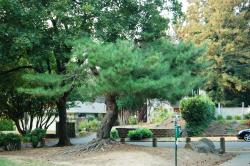
Statistics
DBH (diameter at breast height): 23 inches
Height: 21 feet
Spread: 35 feet
Neighborhood: Hough
Location: John Ball Park
Heritage Tree ID: HT39
Japanese Snowbell
Styrax japonicus
History/Information
Nominated by a local Master Arborist, this is truly an exceptional representative of this lovely flowering tree. The tree’s showy white bell shaped flowers bloom in late April and cascade throughout the tree. This particular tree is very large for the species and is therefore is very rare. It is estimated that the tree is over 75 years old. Native to the far east, Japanese Snowbell was traditionally used to make prayer beads and umbrella handles.
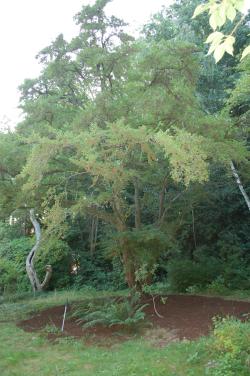
Statistics
DBH (diameter at breast height): 28 inches
Height: 37 feet
Spread: 47 feet
Location: 3412 Southeast Riverwood Lane
Heritage Tree ID: HT32
London Planetree
Platanus x acerifolia
History/Information
Designated as a Heritage Tree in 2002, this tree serves the residents of the Lincoln neighborhood as a reminder of the value of preserving our city’s urban canopy and the legacy that old trees represent.
The London planetree, a hybrid of the Oriental planetree and the American sycamore, was bred to maintain the growth habit and exfoliating bark of the American sycamore while providing resistance to the diseases that traditionally afflict that species. Its relative disease resistance and drought tolerance make it a useful Pacific Northwest shade tree.

Statistics
DBH (diameter at breast height): 49.5 inches
Height: 80 feet
Spread: 75 feet
Neighborhood: Lincoln
Location: 200 East 38th Street
Heritage Tree ID: HT17
Mayor’s Grove
Mixed species
History/Information
The “Mayor’s Grove” of trees is located at the northwest corner of Mill Plain Boulevard and Fort Vancouver Way in Central Park. The grove was first planted in 1971-72 by and for the mayors of the City of Vancouver. In 1987 the grove was officially designated for the purpose of commemorating each individual mayor. Each new incoming mayor of Vancouver will add to the collection by choosing a tree species to plant on the first Arbor Day of their term.

Statistics
DBH (diameter at breast height): 30+ inches
Height: 60+ feet
Spread: 45+ feet
Neighborhood: Central Park
Location: south end of Marshall Park
Heritage Tree ID: HT5
Monkey Puzzle Trees
Araucaria araucana
History/Information
Thought to be well over 150 years old, one of two magnificent ancient trees were considered extremely large at first record, over 80 years ago!
The monkey puzzle, also known as a Chilean pine, received its common name from an Englishman in the 1800s, who thought it would certainly be a puzzle for a monkey to climb.

Statistics
DBH (diameter at breast height): 29.5 & 30 inches
Height: 140 feet
Spread: 45 feet
Location: 11418 Southeast Evergreen Highway
Heritage Tree ID: HT19, HT20
Northern Catalpa
Catalpa speciosa
History/Information
Also known as Cigar Tree or Catawba-tree, Northern Catalpa is native to the midwestern states and therefore is not commonly found in our region. Catalpa wood is particularily rot resistance and therefore historically was used for fence posts and railroad ties, though given the striking nature of the grain it has more recently been used for furniture and cabinetry. This particular tree does an excellent job of framing this property that has applied for designation on Vancouver’s Historical Registry.
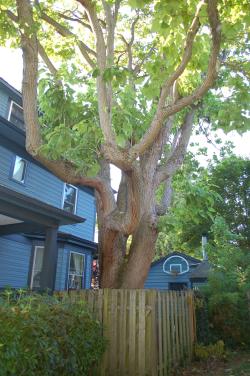
Statistics
DBH (diameter at breast height): 47 inches
Height: 55 feet
Spread: 60 feet
Location: 112 West 28th Street
Heritage Tree ID: HT31
Norway Maples
Acer platanoides
History/Information
This boulevard of maples was closely related to the old Fort Vancouver High School, which was located on the north side of the street. An old photograph of the area (circa 1921) shows the row of trees planted on both sides of West 24th Street. Three out of four of the maples nominated are large enough to date back to the time of the photograph and are most likely the only remnant of the canopy along the street. With over 89 listed cultivars of Norway maple, it is one of the most widely planted trees in the United States.
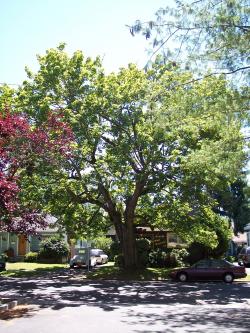
Statistics
DBH (diameter at breast height): 35 inches (average of four trees)
Height: 42.5 feet (average)
Spread: 47.5 (average)
Neighborhood: Hough (Uptown Village)
Location: 117-127 West 24th Street
Heritage Tree ID: HT8
Officers Row
Mixed Tree Species
History/Information
The beautiful trees that line Officers Row on Evergreen Boulevard were planted by the Army when the Barracks were still part of the active military base. The variety of trees creates a wonderful setting for a stroll or jog. Officer’s Row is a splendid example of the temperate Pacific Northwest’s ability to nurture a great diversity of tree species. The Boulevard is dominated by the Pacific Northwest native big-leaf maple (Acer macrophyllum). Other species, American elm (Ulmus americana), black walnut (Juglans nigra), sugar maple (Acer saccharum), Eastern cottonwood (Populus deltoides), Douglas fir (Pseudotsuga menziesii), and Austrian pine (Pinus nigra) were also planted along the Boulevard as either the original planting scheme or subsequently planted throughout the eras.
The tree-lined boulevard boasts 21 preserved Victorian homes that are on the National Historic Register. Built in the mid-to-late 1800s, these beautifully restored homes were built to house U.S. Army officers stationed at Vancouver Barracks; the higher the command the larger the house. The Grant House, built in 1850, now houses The Grant House Restaurant; and the Marshall House, built in 1886, offers tours and an exhibit on General George C. Marshall, it’s most famous resident.
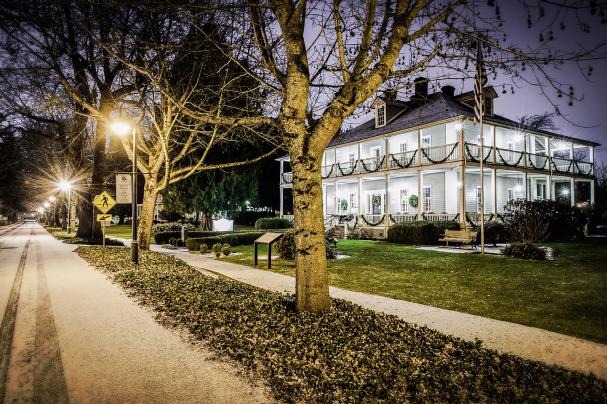
Statistics
DBH (diameter at breast height): 35 inches and up
Height: 55 feet and up
Spread: 50 feet and up
Location: Evergreen Blvd, between Ft. Vancouver Way and Reserve St.
Heritage Tree ID: HT3
Old Apple Tree Offspring
Malus spp.
History/Information
This tree is an offspring of the “Old Apple Tree” (HT1). Thus, this apple tree has a high historic value. The tree was planted as a scion through the efforts of Harley Mays in 1950. This tree was one of the only cuttings to survive.
As a part of the Old Apple Tree Festival each year, The City of Vancouver and its Urban Forestry Commission distribute cuttings of the Old Apple Tree so the public can also share in the history of the city and continue the legacy of the Old Apple Tree, much like Harley Mays.
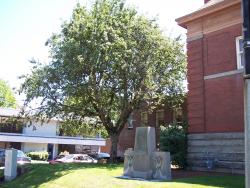
Statistics
DBH (diameter at breast height): 18.5 inches
Height: 30 feet
Spread: 32 feet
Neighborhood: Arnada
Location: Clark County Historical Museum
Heritage Tree ID: HT13
Oregon White Oak – Ogden neighborhood entrance
Quercus garryana
History/Information
This prominent Oregon white oak at the entrance to the Ogden neighborhood is estimated to be 100 to 150 years old. It is one of the few remaining native oak trees that were preserved when the Country Club Village residential subdivision was platted in 1962. Prior to then, the landscape featured open fields dotted with majestic oaks such as this one, visible to passersby from Fourth Plain Road.
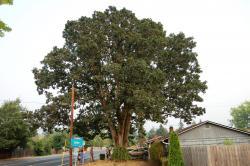
Statistics
DBH (diameter at breast height): 59 inches
Height: 75 feet
Spread: 90 feet
Neighborhood: Ogden
Location: 4214 Northeast Thurston Way
Heritage Tree ID: HT48
Oregon White Oak – Bagley Downs
Quercus garryana
History/Information
This tree represents the largest of the oaks that populated this area long before the area was developed. The area was then much more rural, but the tree was no less impressive.
Native to western British Columbia, Washington, Oregon and northwestern California, Oregon white oak is one of the most majestic of the Pacific Northwest’s deciduous trees.
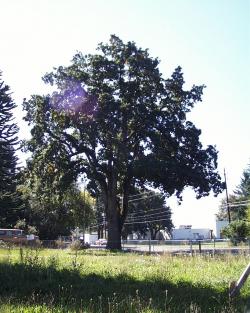
Statistics
DBH (diameter at breast height): 60 inches
Height: 75 feet
Spread: 70 feet
Neighborhood: Bagley Downs
Location: 2811 Northeast Stapleton Road
Heritage Tree ID: HT16
Oregon White Oak – Headache Creek Wetlands
Quercus garryana
History/Information
In the open space utilized as an outdoor classroom by Vancouver Flex Academy stands a large Oregon white oak. This tree is fairly large for the species and has been a fixture in the neighborhood for many years.
Native to western British Columbia, Washington, Oregon, and northwestern California, Oregon white oak is one of the most majestic of the Pacific Northwest’s deciduous trees.

Statistics
DBH (diameter at breast height): 50.5 inches
Height: 70 feet
Spread: 60 feet
Neighborhood: Bagley Downs
Location: Headache Creek Wetlands at Bagley Community Park (southwest of intersection of Nicholson Road and Northeast 43rd Place)
Heritage Tree ID: HT12
Oregon White Oak – Hough (Uptown Village)
Quercus rubra
History/Information
At the location of the old Fort Vancouver High School, this red oak was planted by the students of the high school on June 25, 1945, in honor of the first meeting of the United Nations in San Francisco. The high school is now gone, but the tree remains as a symbol for the creation of the United Nations.

Statistics
DBH (diameter at breast height): 28 inches
Height: 65 feet
Spread: 55 feet
Neighborhood: Hough (Uptown Village)
Location: southwest corner of West Fourth Plain Boulevard and Main Street
Heritage Tree ID: HT4
Oregon White Oak – Oakbrook Park
Quercus garryana
History/Information
Located in Oakbrook Park, this tree is the largest of the remaining Oregon white oaks for which the park was named. It is also the most statuesque.
Native to western British Columbia, Washington, Oregon and northwestern California, Oregon white oak is one of the most majestic of the Pacific Northwest’s deciduous trees.

Statistics
DBH (diameter at breast height): 54.5 inches
Height: 80 feet
Spread: 75 feet
Neighborhood: Oakbrook
Location: Oakbrook Park (next to the tennis courts)
Heritage Tree ID: HT15
Oregon White Oak Grove
Quercus rubra
History/Information
This significant grove of Oregon White Oak trees is reminiscent of the oak woodland and savannah land cover that dominated the valley floors prior to European colonization. Oregon White Oaks are designated a priority species by Washington Department of Fish and Wildlife due to their habitat value. They are the only native oak species in British Columbia, Washington, and northern Oregon. The trees provide critical habitat for a number of rare native species, and this grove abutting to the Burnt Bridge Creek Greenway allows easy access between different habitat zones for wildlife to flourish.

Statistics
DBH (diameter at breast height): varies
Height: varies
Spread: varies
Neighborhood: Meadow Homes
Location: 1707 North Devine Road
Heritage Tree ID: HT45
Paradox Walnut
Quercus coccinea
History/Information
This mature tree is rather unique to this area and it is rare to find a specimen of this in our community. While the dry leaves persist on the tree through the winter, in the fall the tree turns a brilliant shade of red. This tree also serves as a landmark to the Hough Neighborhood as pilots landing at Pearson Airfield use this tree to mark where they need to initiate their turn in order to land.
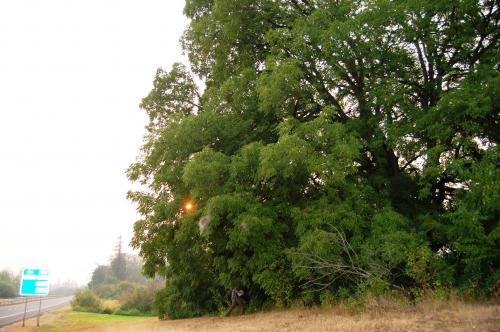
Statistics
DBH (diameter at breast height): 62 inches
Height: 90 feet
Spread: 110 feet
Neighborhood: Vanmall North
Location: Northeast Padden Parkway and Andresen Road
Heritage Tree ID: HT43
Red Oak (UN Tree)
Quercus rubra
History/Information
At the location of the old Fort Vancouver High School, this red oak was planted by the students of the high school on June 25, 1945, in honor of the first meeting of the United Nations in San Francisco. The high school is now gone, but the tree remains as a symbol for the creation of the United Nations.

Statistics
DBH (diameter at breast height): 28 inches
Height: 65 feet
Spread: 55 feet
Neighborhood: Hough (Uptown Village)
Location: southwest corner of West Fourth Plain Boulevard and Main Street
Heritage Tree ID: HT4
Scarlet Oak
Quercus coccinea
History/Information
This mature tree is rather unique to this area and it is rare to find a specimen of this in our community. While the dry leaves persist on the tree through the winter, in the fall the tree turns a brilliant shade of red. This tree also serves as a landmark to the Hough Neighborhood as pilots landing at Pearson Airfield use this tree to mark where they need to initiate their turn in order to land.

Statistics
DBH (diameter at breast height): 57 inches
Height: 90 feet
Spread: 125 feet
Location: 511 West 21st Street
Heritage Tree ID: HT30
The Old Apple Tree
Malus spp.
History/Information
Vancouver’s Old Apple Tree is the greatest living symbol of the Pacific Northwest’s orchard industry. Its modest beginning has been traced to the whimsical flirtations of an English woman in 1825.
Historical detectives have learned from diary entries that Lt. Aemilius Simpson, an officer in the Royal Navy, was attending a formal dinner on the eve of his departure to the rugged Pacific Northwest. A young female admirer collected some apple seeds left over from the fruit dessert that evening. She dropped the seeds in Lt. Simpson’s dinner jacket pocket and said, “Plant these when you reach your Northwest wilderness.” Simpson forgot about the seeds during his long sea voyage across the Atlantic Ocean, around Cape Horn and north through the Pacific to the Columbia River
When he reached Fort Vancouver he donned the jacket for a formal dinner given in his honor by Dr. John McLoughlin. In 1826, under the direction of McLoughlin, the seeds were planted. One of the five original apple trees, the Old Apple Tree is the only one to survive. It has stoically withstood flood, wind, and the steady encroachment of the railroad and Highway 14.
On October 19, 1984, the venerable Old Apple Tree was celebrated during the festive opening of Old Apple Tree Park, located at 112 Columbia Way. The tree is now celebrated each fall at the Old Apple Tree Festival.
The Old Apple Tree remained remarkably vigorous for it’s age and significant internal decay for 194 years. In June of 2020 city arborists conducted a thorough evaluation and observed that the cambium layer of the tree, which transports water and nutrients to the canopy, had been disrupted when the tree shifted slightly. Fortunately, the Old Apple Tree Research Team had been planning ahead by nurturing several of the root suckers, which are now small trees growing around the Old Apple Tree.
Following the recommendation of this research team of professionals, one sapling located near the center of the 194-year-old Old Apple Tree will be cultivated to flourish as part of the historical landscape. This sapling will continue to be called the Old Apple Tree, as it is the same root system with a new stem.
The new tree will be structured to mimic the Old Apple Tree, in recognition of the historic site. The remaining shell of the 194-year-old tree, about 4 feet to 5 feet tall, will remain for visual interpretation of the tree’s life cycle. Any other portions of the old tree that are removed will be put in the National Park Service Museum collection to be preserved.
The remaining saplings will be transplanted to the National Park Service historic orchard, likely during the fall or winter of 2020-2021. The Old Apple Tree will also live on in offspring planted around the community. One of the notable offspring is Heritage Tree #13, located at the Clark County Historical Museum.
The tree produces fruit, a tart green apple best used in cooking or cider. The fruit is simply known as an English Greening apple.
Bob Cromwell, Archeologist with the National Parks Service and Fort Vancouver, wrote a detailed history of the Old Apple Tree, which you can view here.
The Old Apple Tree is a tangible reminder of the power of trees to bridge generations and provide continuity between the past and the future. By planting trees today, we leave a legacy for future generations to enjoy. Trees greatly enhance our quality of life here in Vancouver by beautifying our neighborhoods and parks, cleaning the air and water, and providing numerous other environmental, social and economic benefits.
The Old Apple Tree in the news
A 194-year-old apple tree, the matriarch of the Northwest apple industry, has died. CNN. 8/24/2020.
Vancouver’s historic Old Apple Tree will live on. Clark County Today. 8/14/2020.
Vancouver’s Old Apple Tree dies at age 194. The Columbian. 6/27/2020
Helping the Old Apple Tree grow. The Columbian. 2/27/2010.
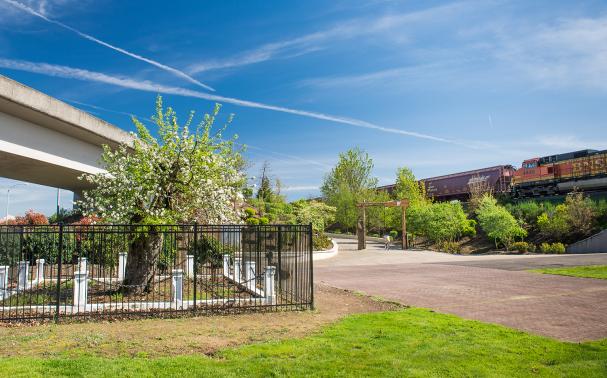
Statistics
Prior to the main tree failure in June 2020
DBH (diameter at breast height): 31 inches
Height: 32 feet
Spread: 35 feet
Several root saplings are alive
DBH: up to 2 inches
Height: up to 25 feet
Spread: up to 5 feet
Location: Old Apple Tree Park
Heritage Tree ID: HT1
Western White Pine
Pinus monticola
History/Information
This beautiful specimen towers over SE Evergreen Highway, something this tree has done for over 150 years. This was threatened with removal years ago so a jogging trail could be built, but thanks to the efforts of local citizens the tree was spared and will be preserved.
The botanist David Douglas first identified western white pine on the slopes of Mount St. Helens. Also known as silver pine, it gets its common name from the light color of the wood. The Latin name monticola means “inhabiting mountains”.

Statistics
DBH (diameter at breast height): 55 inches
Height: 175 feet
Spread: 50 feet
Location: 11418 Southeast Evergreen Highway
Heritage Tree ID: HT21
Tuliptree
Liriodendron tulipifera
History/Information
Also known as a tulip poplar or yellow poplar, tuliptree is a large ornamental tree that is best suited for an open yard or boulevard. This tree stands out among the trees in Rose Village and has been prized by the neighborhood for many years. The tree’s name reflects both the shape of the leaves and the structure of the flower, which usually emerge in late May or early June. Tuliptree is very showy in the fall with bright yellow colors mottled with areas of brown.
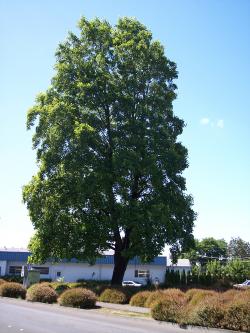
Statistics
DBH (diameter at breast height): 36.5 inches
Height: 78 feet
Spread: 50 feet
Neighborhood: Rose Village
Location: intersection of St. Johns Boulevard & East 33rd Street
Heritage Tree ID: HT25
White Ashes
Fraxinus Americana
History/Information
Also known as American biltmore, white ash has been prized for years as the best wood to make baseball bats, hockey sticks and other sporting goods. White ash is also known for its beautiful fall color which can vary from bright red to deep purple. Each fall these trees brighten up the intersection of East Mill Plain Boulevard and Grand Avenue. Ash trees (both green and white) are under attack in the Midwest by an exotic pest, known as emerald ash borer. Research is being done on how best to contain the pest, but this pest poses a grave danger to our nation’s ash populations.

Statistics
DBH (diameter at breast height): 37, 35.5, & 28 inches
Height: 75 feet
Spread: 40 feet
Location: Old City Cemetery
Heritage Tree ID: HT27, HT28, HT29

